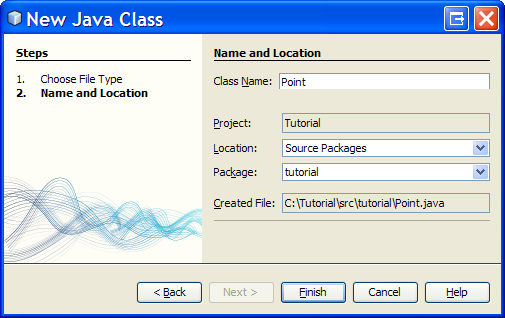Step 2: Define a JPA Entity Class
To store objects in an ObjectDB database using JPA we need to define an entity class:
- Open the [New Java Class] dialog box, e.g. by right clicking the tutorial package node
(in the [Projects] window) and selecting New > Java Class...
- Enter Point as the class name - use exactly that case sensitive class name.
- The package name should be tutorial.
- Click Finish to create the new class.

Use copy and paste to fill the new source file with the following content:
package tutorial; import java.io.Serializable; import javax.persistence.*; @Entity public class Point implements Serializable { private static final long serialVersionUID = 1L; @Id @GeneratedValue private long id; private int x; private int y; public Point() { } Point(int x, int y) { this.x = x; this.y = y; } public Long getId() { return id; } public int getX() { return x; } public int getY() { return y; } @Override public String toString() { return String.format("(%d, %d)", this.x, this.y); } }
The new class should represent Point objects in the database. Besides the @Entityjakarta.persistence.Entity - JPA Annotation Declares that the annotated class is an entity. annotation and the id field (and its annotations) - the Point class is an ordinary Java class.
The warning that NetBeans displays on the Guest class indicates that a persistence unit definition in an XML file is missing. This is discussed in the ObjectDB Manual. But nevertheless, this class is a valid ObjectDB entity class, despite the warning.
The next step is adding a Main class that stores and retrieves instances of the Point entity class.